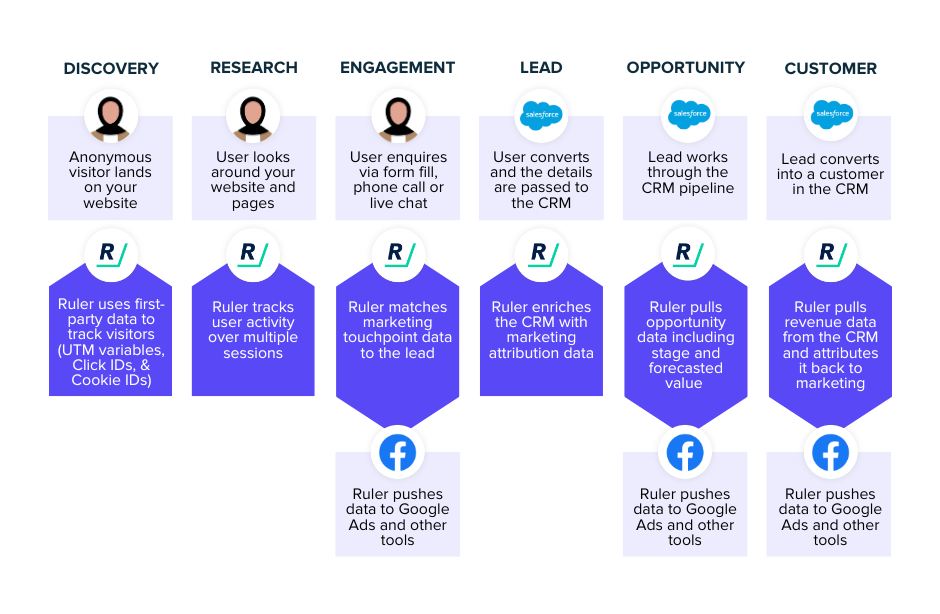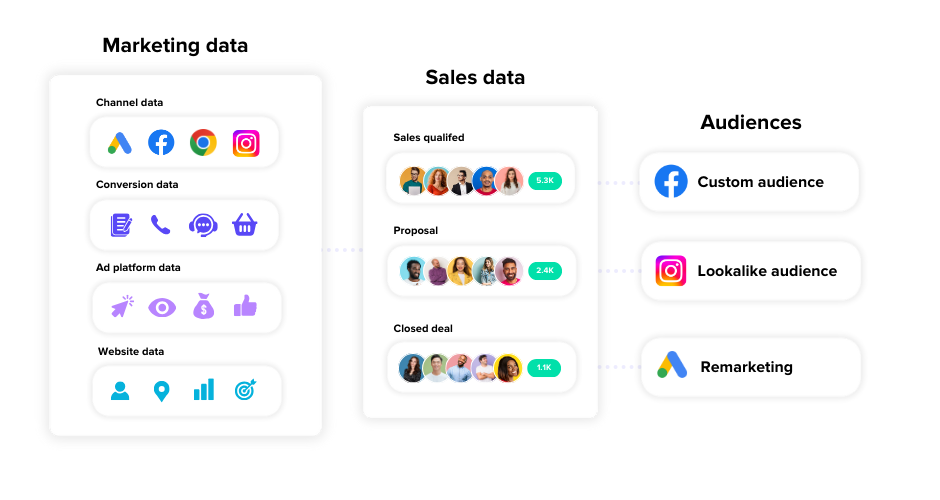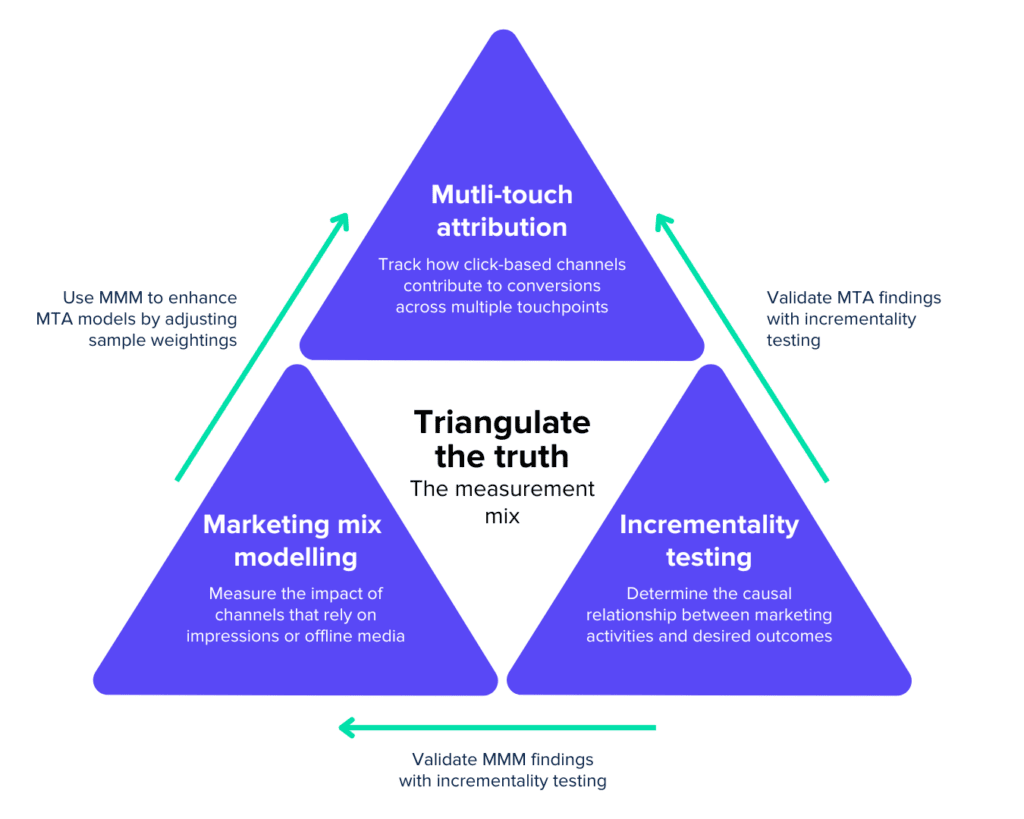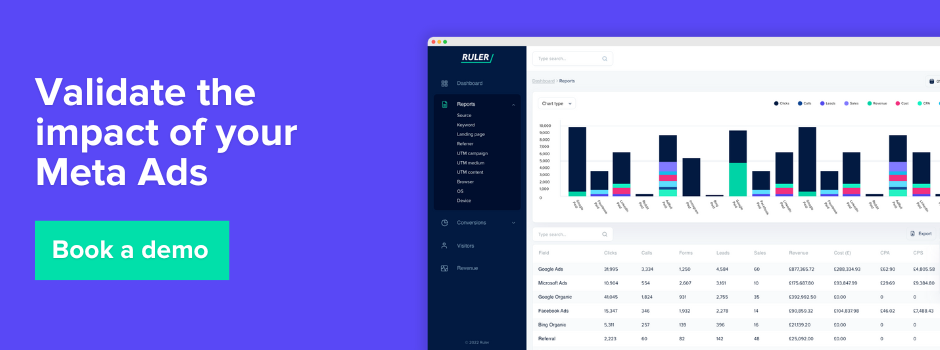Learn why Meta attribution falls short and how first-party data, MMM, and incrementality testing give a clearer view of marketing performance.
For years, Facebook’s attribution system has helped marketers understand which ads drive performance.
It offered a structured view of what worked, helping teams optimise spend and audiences with confidence.
But the ground has shifted.
Meta’s attribution model now operates under heavier constraints.
Privacy changes, shortened attribution windows, and gaps in cross-platform tracking mean the platform’s data often tells only part of the story.
As a result, marketers have less clarity on what’s working, and more room for wasted budget.
This guide breaks down how Meta attribution works today, where it falls short, and how to shift your approach to get a clearer view of Facebook performance.
We discuss:
💡 Pro Tip
Meta attribution is incomplete. Apple’s ATT and iOS 14.5 have already reduced your ability to track user behaviour and measure ad effectiveness. But even before that, attribution in Meta had limitations – platform bias, duplicated credit, and no native support for offline conversions.
Ruler tracks UTMs, click IDs, referrers, and page views across the entire customer journey, linking each touchpoint to conversions like calls, forms, and chats. This data is then synced with your CRM or ecommerce platform, giving you visibility into what led to offline actions, like sales meetings or demos.
When a lead reaches a key stage in your pipeline or completes a purchase, Ruler sends that data back to your ad platforms using the original click identifier. This feedback loop improves attribution accuracy, helping you bid more effectively, optimise spend, and give fair credit across all channels, reducing duplication and bias.
Book a demo and find out how to reduce duplication and bias in attribution
Table of Contents
Meta’s attribution system is built on the principle of assigning credit to the ad interactions that lead to a conversion.
Related: What is marketing attribution? A guide to models, practices and what’s changing
It tries to determine which touchpoints influenced someone to take a defined action, such as making a purchase or submitting a lead form.
For Meta attribution to apply, you need to be optimising for conversions that happen outside Meta’s platforms, usually on your website.
These conversions might include completing a purchase, submitting contact details, signing up for a newsletter, or other key actions defined by a standard event, custom event, or custom conversion.
For example, someone might land on a product page (View Content), add an item to their cart (Add to Cart), begin entering payment details (Initiate Checkout), and finally complete the transaction (Purchase).
Alternatively, they might complete a registration or submit a lead form.
To attribute these events back to your ads, the platform uses the Meta Pixel.
This is a browser-based tracking tool that captures on-site behaviour and sends it back to Meta’s systems.
When someone clicks on your ad and later completes a tracked action on your site, Meta can connect those dots and credit the ad for the conversion, depending on the attribution settings you’ve selected.
In January 2021, Meta made major changes to its attribution tools in response to Apple’s App Tracking Transparency (ATT) framework.
With the rollout of iOS 14, Meta lost visibility into some user activity on Apple devices.
As a result, attribution accuracy declined, especially for advertisers targeting iOS users.
To help recover lost data, Meta now recommends using the Conversions API (CAPI) alongside the Pixel.
Related: How does conversion tracking work on Facebook (Meta)
While the Pixel relies on browser data, CAPI sends event data directly from your server to Meta.
This helps fill in tracking gaps caused by browser restrictions, ad blockers, or privacy settings, giving you some control over how your ads are performing.
Building on how Meta tracks and attributes conversions, it’s important to understand the attribution models and windows that shape how credit is assigned within the platform.
Meta offers a few attribution settings within Ads Manager:
These models define the time window during which a conversion can be credited to an ad after someone either clicks on it or sees it.
Regardless of the setting you choose, Meta attribution is based on a last-click model within that window.
So if someone clicks two of your ads, Meta will credit the last one they clicked, provided it happened within its attribution window, even if it wasn’t the final touchpoint in the full customer journey.
For example, imagine someone clicks a Meta ad on Monday, then a Google ad on Thursday, and finally converts via email on Friday. Meta will only claim credit if the conversion falls within its ecosystem and selected attribution window, in this case, the Monday click.
By default, Meta uses a 7-day click and 1-day view window.
That means if someone clicks on your ad and converts within seven days, Meta will attribute the conversion to your ad.
If someone only views the ad, they must convert within 24 hours for it to count. So if they saw the ad two days ago but convert today without clicking, Meta will not claim credit.
Likewise, if they clicked the ad a week ago and convert today, on day eight, it falls outside the window.
Before 2021, these attribution windows were longer.
Meta supported up to 28-day click-through and 1-day view-through attribution, which gave advertisers more flexibility and a broader picture of user behaviour across time.
But with the release of iOS 14.5 and Apple’s ATT policy, Meta shortened its default windows to comply with new privacy standards.
These shorter windows introduce real gaps in the data. Say someone sees your ad on Monday, spends a few days researching your product, compares alternatives, and makes a purchase the following Tuesday.
Even though the Meta ad played a meaningful role in starting the journey, the conversion falls outside the attribution window.
Meta doesn’t get the credit, and your campaign’s impact is underreported.
The release of iOS 14.5 in April 2021 marked a turning point for digital advertising.
As we’ve briefly mentioned above, for Meta’s attribution in particular, it was a moment of significant disruption.
Apple’s App Tracking Transparency (ATT) framework required apps to ask users for explicit permission to track their activity across other apps and websites. Many users declined.
Related: iOS 14.5 update: how to best prepare as a paid marketer
Before iOS 14.5, Meta relied on deterministic tracking, using precise identifiers to follow users across platforms and devices.
The most important of these was Apple’s Identifier for Advertisers (IDFA), which allowed Meta to link ad interactions to real user behaviour with a high degree of accuracy.
With this data, Meta could build detailed user profiles and attribute conversions across sessions, devices, and channels.
Once users started opting out of tracking in large numbers, that level of precision disappeared.
Meta lost access to key behavioural signals and could no longer follow users with the same confidence.
Attribution accuracy fell sharply.
Many advertisers saw reported conversions drop by 50% or more, not because their campaigns stopped working, but because Meta couldn’t connect the dots between ad exposure and purchase behaviour.
In response, Meta shifted to probabilistic attribution models.
Rather than relying on direct user tracking, it began estimating attribution using aggregated data and statistical assumptions.
While this helped fill some gaps, the loss of deterministic tracking meant marketers had to accept greater uncertainty in their reporting.
These changes also affected Meta’s ability to track users across devices.
Where the platform once had a clear view of how someone moved from mobile to desktop or vice versa, that connection is now often broken.
This results in fragmented attribution, underreporting Meta’s influence, and making it harder to measure how ads drive conversions across the full customer journey.
Meta’s attribution system operates within a closed ecosystem.
It tracks and assigns credit only to interactions that happen within its own platform.
This approach offers detailed insights into how users engage with Meta ads, but it ignores the wider context of the customer journey.
Today’s customer journey is rarely confined to a single platform.
A person might first encounter your brand through a Facebook ad, then search for more information on Google, browse your site, engage with email campaigns, and finally convert through a direct visit.
Meta’s attribution model will only register and credit the initial Meta touchpoint, leaving out the influence of every other channel that helped move the customer toward conversion.
This siloed view becomes even more problematic when multiple platforms are involved in paid campaigns.
If a user clicks a Facebook ad, then a Google ad, and eventually makes a purchase, both platforms will claim credit for the conversion.
Without deduplication, marketers can end up overcounting conversions, inflating return on ad spend, and making flawed decisions about where to invest.
The challenge is even greater for businesses with long and complex sales cycles.
In B2B, for instance, a prospect might engage with a Facebook ad, sign up for a webinar via Google Ads, download resources through email, and convert weeks later after a sales call.
Meta attribution alone can’t show how these touchpoints worked together.
It can lead marketers to overvalue the initial impression and undervalue the later interactions that actually closed the deal.
Without cross-platform attribution, you’re only seeing one part of the picture. And that can lead to decisions that don’t reflect how your marketing truly works.
Meta’s attribution capabilities become even more limited when the customer journey extends beyond the digital environment.
While the platform can track online conversions such as purchases, form submissions, and email signups, it cannot natively measure the offline outcomes that often carry the most business value.
This limitation is especially relevant for lead generation campaigns, where an online action is only the first step in a longer sales process.
A potential customer might click a Meta ad and complete a contact form, a conversion Meta can track and attribute.
But what follows often happens offline:
Meta sees only the form submission, not the contract signed weeks or months later that ultimately justifies the ad spend.
The issue isn’t limited to B2B sales.
Offline engagement plays a role in many sectors.
Trade shows, in-store visits, phone enquiries, and referral conversations all reflect marketing success but fall outside Meta’s native measurement tools.
For example, a retailer might use Meta ads to drive traffic to physical shops, but without additional tracking systems, there’s no way to link ad spend to in-store sales.
This attribution gap becomes even more pronounced in businesses with longer sales cycles and multiple decision-makers.
In many B2B cases, the person who clicks the Meta ad isn’t the one making the final purchase.
They might forward information to others, raise internal interest, or contribute to a buying decision in ways that leave no visible trace in Meta’s reporting.
As a result, Meta attribution often undervalues the early-stage campaigns that generate awareness and influence key stakeholders, despite their real impact on revenue.
The challenges with Meta’s attribution system are clear.
It operates in a silo, credits only the interactions it can see, and loses visibility once a journey moves across platforms or into offline channels.
Privacy changes like iOS 14.5 have further limited its tracking capabilities, leading to incomplete reporting, duplicated credit, and under-recognition of the true drivers of business outcomes.
To move forward, marketers need a way to see beyond Meta’s walls and understand the full path to conversion.
First-party data attribution platforms offer exactly that shift.
Instead of measuring performance from the perspective of a single platform, they focus on the customer.
These systems connect touchpoints across the entire journey, across channels and into offline interactions, by using multiple identifiers to link behaviour over time.
When someone clicks a Meta ad, a first-party attribution platform captures the event and associates it with identifiers like click IDs, cookies, device IDs, and IP addresses.
Related: 4 steps to create a first-party data strategy

As the person continues to engage, through email, paid search, organic visits, or direct interactions, those touchpoints are connected through shared identifiers.
This builds a single, connected timeline of the customer’s journey.
The approach becomes even more powerful when a customer provides contact details via an online form.
At that point, previously anonymous browsing and interaction data can be tied to identifiable information like an email address or phone number.
What was once a series of disconnected events becomes a unified profile showing exactly how the customer moved from first touch to conversion.
This data can then be connected to offline outcomes through CRM or ecommerce integrations.
If a lead from Meta advertising goes on to speak with a sales rep, attend a demo, or complete a high-value purchase, those events are captured and linked back to the original marketing activity.
It becomes possible to see not just who converted, but which campaigns led to meaningful business outcomes.
These insights can be sent back to Meta for optimisation.
Feeding higher-quality conversion data, including offline events, into the platform allows its algorithms to learn which audiences and creatives bring in high-value customers, not just those who convert quickly online.
This supports more effective bidding and targeting strategies focused on customer lifetime value.
Finally, by understanding the full customer journey, marketers can build more advanced audiences.
Lookalikes can be based on people who completed valuable offline actions, not just filled out a form.
Retargeting strategies can account for sales engagement, so that leads already in discussion with sales aren’t repeatedly shown awareness messaging.
And exclusion rules can be refined to improve efficiency across the funnel.

First-party attribution is not just a technical solution, it’s a strategic upgrade.
It gives marketers the tools to measure what matters and optimise for real outcomes, not just clicks and forms.
💡 Pro Tip
Using our in-house first-party tracking, we connect click IDs, cookies, and engagement data to actual business outcomes and spend. This gives marketers a clear, reliable view of ROI and ROAS. Book a demo to see how unified attribution can support better decisions.
First-party attribution provides a more complete view of user journeys by linking deterministic identifiers, click IDs, cookies, device data, and other session-level variables.
It allows marketers to see how users interact with multiple channels and convert across devices and over time. But it also has its limits.
Meta campaigns are often used at the upper funnel, particularly to drive awareness through impressions rather than clicks.
As outlined earlier, Meta’s view-through attribution window is just one day.
If someone sees a Meta ad but converts days later without clicking, the platform will not record that interaction.
And since first-party systems rely on deterministic signals like clicks, they too fall short when measuring the full impact of non-click engagements.
This blind spot makes it difficult to assess the true effectiveness of brand awareness led activity.
To overcome these gaps, marketers need to pair first-party attribution tracking with other measurement methods, particularly marketing mix modelling and incrementality testing.

MMM doesn’t track individual users. Instead, it uses statistical analysis to assess how changes in marketing inputs, spend, impressions, reach, seasonality, and pricing, affect outcomes like sales or leads over time.
This aggregate-level approach is well suited to measuring the broader impact of Meta campaigns, including upper-funnel efforts where clicks are sparse or missing.
Because MMM evaluates how performance shifts with different levels of spend, it can identify points of diminishing returns. This insight helps marketers reallocate budgets more effectively across channels.
Attribution models, whether platform-based or first-party, focus on crediting conversions that already happened.
But they can’t answer the more important question: would the conversion have occurred without the advertising?
To answer that question, you need incrementality testing.
Incrementality methods, like geo-lift testing, isolate the true causal impact of campaigns by comparing results between exposed and unexposed groups.
In a geo-lift test, for instance, ads are shown in some geographic regions and held back in others.
By analysing the difference in outcomes, marketers can quantify the actual lift driven by the campaign.
These tests often reveal insights that attribution alone misses.
A campaign with strong attributed results may show low incrementality if it simply reaches people who were already likely to convert.
On the other hand, a campaign with low attributed performance might prove highly incremental if it successfully captures new demand or reaches audiences that weren’t previously engaging.
Using all three approaches together, first-party attribution, MMM, and incrementality testing, gives marketers a much deeper understanding of what works.
💡 Pro Tip
By combining attribution with incrementality testing and marketing mix modelling, you can build a more accurate picture of marketing performance. This integrated approach helps you understand what’s truly driving results, avoid misleading metrics, and make more confident budget decisions. Our marketing measurement framework breaks down each method and shows you how to put them into practice.
Attribution shows which tactics correlate with conversions, MMM reveals how different channels interact and identifies diminishing returns, and incrementality confirms whether the observed performance is actually caused by the marketing activity.
Together, they allow for better budget allocation, more accurate performance reporting, and fewer decisions based on flawed or incomplete data.
They also resolve channel conflicts.
Rather than debating whether Meta or Google deserves credit, incrementality testing can measure their combined effect and show how different platforms support each other.
In short, no single method is sufficient. But when used together, these measurement techniques provide clarity where attribution alone falls short.
Attribution has never been simple, but changes in tracking, privacy, and platform constraints have made it harder than ever to understand what’s truly driving results.
Meta’s native attribution offers useful insights, but only within its own ecosystem, and only for a narrow slice of the customer journey.
It misses what happens across platforms, offline, and outside short attribution windows.
These blind spots can lead to wasted spend and missed opportunities.
First-party attribution offers a more complete alternative. It captures click-level interactions across channels and connects them to real customer outcomes, including those that happen offline.
But to get the full picture, marketers need more than click data.
Combining first-party tracking with tools like marketing mix modelling and incrementality testing provides the depth and confidence needed to make smarter decisions and allocate budget effectively.
If you’re struggling with limited visibility or want to better understand how your marketing drives real business outcomes, it might be time to take a different approach.
Book a demo of Ruler to see how a joined-up measurement strategy can give you the clarity Meta can’t.
